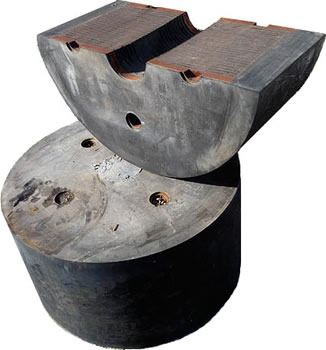Much new knowledge was gained over the decades about earthquake engineering after the Bridge was completed in 1937. Two retrofit strategies have been used recently on the Bridge: (1) making some key elements stronger, and (2) using seismic isolators on approaches to the Bridge to reduce the earthquake motions that they experience.
Seismic Isolation
This short video compares the sideways movement of a traditional structure on a rigid foundation (left) with one mounted on seismic isolators (right). The isolators reduce the severity of shaking transmitted up into the structure and make the vibrations slower and less jerky. You can see seismic isolators, short black cylinders about 3 feet (1 m) in diameter, under the roadway decks of approach spans at the north and south ends of the Bridge.

When a bridge is rigidly connected to the ground, it directly experiences the rapid, jerky earthquake shaking. If the bridge is mounted on seismic isolators, the isolators deform back and forth during the earthquake allowing a bridge to rock back and forth, softening the vibrations that the structure experiences. When a bridge is isolated, the forces can be reduced by as much as two-thirds as compared to a non-isolated bridge.

Invented in New Zealand in the 1970s, a common type of isolator like the one shown above is made of layers of steel and rubber bonded together. Sometimes there is a hole in the middle in which a lead plug is inserted to increase energy absorption. These are also called lead-rubber bearings.
More Images
 |
The isolator shown here has been cut to reveal its cross-section (with layers of steel and a special type of rubber). |
Explore this Topic Further
How Seismic Isolation Works
Seismic Isolation - California Academy of Sciences (grades K-12)
This web page compiles a variety of resources about base isolation aimed at K-12 students and teachers.
Advanced Earthquake Resistant Design Techniques from MCEER (grade 6 through adult)
This web page describes two types of seismic isolation devices (lead-rubber bearings and spherical isolators). It also describes how energy dissipation devices work.
Seismic Retrofit of the Golden Gate Bridge
Overview of Golden Gate Bridge Seismic Retrofit Construction Project (grades 6 to adult)
On this web site the Golden Gate Bridge, Highway and Transportation District (GGBHTD) summarizes the timeline, phases of design and construction, as well as the reasoning behind the bridge seismic retrofit program. The Golden Gate Bridge Seismic Retrofit Phase II was named the recipient of the 2007 Outstanding Civil Engineering Achievement (OCEA) Award by the American Society of Civil Engineers.
Animation of the Golden Gate Bridge in an Earthquake created by Computers & Structures, Inc. (all ages)
This highly exaggerated animation shows the types of vertical, horizontal and twisting motions that the Golden Gate Bridge would experience in a repeat of the 1906 earthquake. (20 second video)
Seismic Retrofit of the Golden Gate Bridge by Tim Ingham, Santiago Rodriguez, Marwan Nader, & Fabio Taucer, 1996 (adult)
This conference paper written by engineers at T.Y. Lin International gives an overview of the seismic retrofit of the Golden Gate Bridge including ground motions, design criteria, analysis methodology, installation of viscous dampers, and retrofit of the lateral bracing, towers, piers, cable saddles, wind-locks, and deck.
Seismic Retrofit of the Towers of the Golden Gate Bridge by Marwan Nader & Tim Ingham, 1996 (adult)
This rather technical conference paper written by engineers at T.Y. Lin International discusses in detail the procedures and design methods used to retrofit the towers that support the Golden Gate Bridge.
Seismic Protective Systems for the Stiffening Truss of the Golden Gate Bridge by Santiago Rodriguez & Tim Ingham, 1996 (adult)
This conference paper written by engineers at T.Y. Lin International summarizes the design of the seismic retrofit of the Golden Gate Bridge stiffening trusses. The paper discusses the analysis method, the modeling techniques, and the seismic response of the bridge.
Seismic Isolation Bearings from the Golden Gate Bridge, Highway and Transportation District (GGBHTD)
Approach spans that lead to the suspension bridge at its north and south ends have been seismically retrofitted with seismic isolation bearings, which function like shock absorbers to reduce the intensity of earthquake shaking experienced by the structure.
Reinforced Concrete Plyon from the Golden Gate Bridge, Highway and Transportation District (GGBHTD)
Facilities Engineer Jorge Lee, standing by a reinforced concrete pylon at the south end of the arch over Fort Point, showing that seismic retrofitting required adding a new layer of reinforced concrete to that structure. The Bridge District used concrete formwork made of wooden boards, which leave their imprint on the concrete, to match the historic 1930s appearance of the Bridge.
Accelerometers from the Golden Gate Bridge, Highway and Transportation District (GGBHTD)
Bridge Manager Kary Witt shows one of the 175 instruments (accelerometers) mounted on the Bridge that measure the intensity of earthquake shaking and explains how the Bridge District engineers use that data.
Hands-on Activities
Base Isolation by Leslie Bucar and Dan Johnson (grades 6-12)
In this activity participants observe how base isolation protects buildings during an earthquake using horizontal rollers to model base isolators and masses on rods to model a building.
Base Isolation for Earthquake Resistance from the Cascadia Earthscope Earthquake and Tsunami Education Program (grades 6-12)
This teacher workshop module provides background information and two activities for demonstrating base isolation. One unit uses the Building Oscillation Seismic Simulation (BOSS) model published in the FEMA Seismic Sleuths teacher resources.